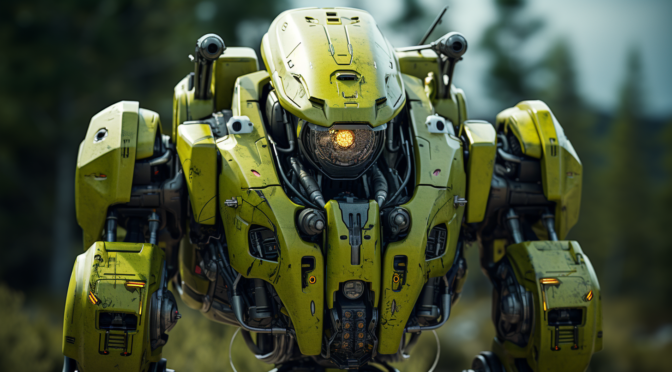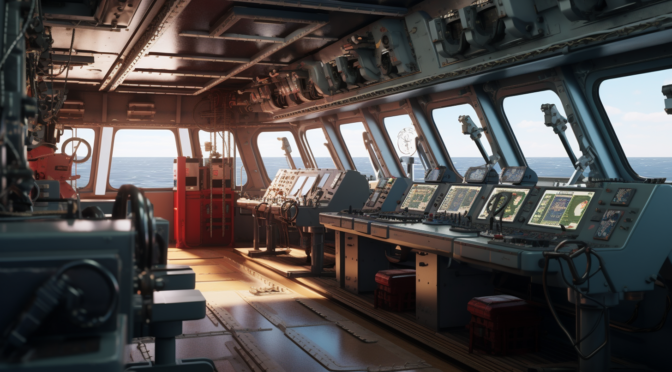Fiction Week
By LtCol Robert L. Burton, USMC (ret.)
Transiting the Strait had been a highly anticipated movement for the Maritime Sealift Command crews in recent months. While maritime commerce usually flowed smoothly through the waters, the deteriorating security situation in the region due to Centralia’s recent belligerence had raised concerns. As Centralian forces focused on antagonizing their neighbors in Montanya, pirates and other outlaws exploited the fragile security on the high seas. Meanwhile, U.S. forces were heavily engaged in a security cooperation campaign to support their regional allies. Strategic sealift requirements through the Strait had not only increased but also carried greater consequences of failure.
The USNS Apalachicola’s current mission through the Strait exemplified this heightened importance. The ship’s humanitarian assistance cargo was crucial for an ally whose coast had been ravaged by a recent typhoon. Without these supplies, thousands of people would continue to suffer, potentially destabilizing the region further.
This particular transit was also notable for other reasons. This was the first time that Merchant Marine Cadets Deville, Thompson, and Sparkman had made the transit as part of their ‘Sea Year’ duty. Cadet Deville, the Engine Cadet, hailed from the Midwest and was always seen with a wrench in hand and grease on his face. Thompson, a laid-back Bostonian, was the Deck Cadet and the son of a fisherman. Cadet Sparkman, an Alabama native, was the assigned Cyber Cadet, a relatively new position for Merchant Mariners, and responsible for cybersecurity. The midshipmen were about halfway through their Sea Year Duty, but they had competently adjusted to their duties. Unique for them, however, was their assignment to the EPF-13 Apalachicola, a crew-optional vessel. Although they manned their stations from a darkened operations room in Norfolk, they did not take their responsibilities any less seriously.
_________________________________________
As the Apalachicola approached the Strait, Cadet Sparkman sat up at his desk. Although he realized the approach would take a couple hours, his intuition suggested that this transit would require his acute attention. He reached for an energy drink beside his monitor, took a healthy gulp, and began typing furiously on his keyboard. He scrolled through multiple open applications spread across three screens at his workstation. At one point, he reached for a clipboard, reviewing the daily cyber threat report. He recognized most of the top tier threats and followed down the list with his finger until he came across a less familiar one: “MAROON STORM.” A ubiquitous name, but he recognized by its nomenclature that the source of this particular threat was an emerging actor and thus more interesting since less was known about the actor’s intentions and motives.
_________________________________________
As Cadet Sparkman continue to review the information about MAROON STORM, he received his first alert that his intuition may have been right. He scanned through his systems logs and saw the first clue. A sensor on the bridge that measured windspeed had failed to function for two minutes. At the Apalachicola’s current speed, windspeed was most certainly measurable. But not strong enough for any wiring to come loose. Cadet Sparkman calmly turned the sensor off and waited for two minutes before turning it back on.
Sparkman glanced at his watch after only 30 seconds, trying to stave off his impatience, but then his mind began drifting off towards his Sea Year Project. The Sea Year Project was one of the other pressures that Merchant Marine midshipmen endured during their first at-sea duty. Like a six-month long homework assignment, it occupied much of their free time; however, its relevance to their current duty made it important to stay on top of. Each day he chipped away at his project and learned something new he could apply during his next duty rotation.
A thought occurred to him, and Sparkman activated the transmit button on his headset. “Cadet Thompson, this is Sparkman, over.”
Thompson responded, “This is Thompson. What’s up, Sparky?”
“Hey, I know you’re busy rolling up maps and stowing the sails and all,” Sparkman began, “but would you mind checking on the starboard anemometer? I think we may have an intrusion.”
“Hah. Yeah, okay. I’ll check on it,” Thompson replied.
Cadet Thompson was accustomed to Sparkman’s jocular insults. There was a misperception that Deck Cadets had a more leisurely role aboard ships, focused simply on navigating and steering. However, their academic studies, centered on logistics, business principles, and security, were just as crucial to maritime trade as the studies of the cyber or engine cadets, who specialized in propulsion and maritime engineering.
A few moments later, Cadet Thompson returned the call. “Hey, Sparky. I checked the anemometer, and it’s working fine. But you’re right about the readings; something’s interfering at the terminal.”
Sparkman acknowledged, “Copy that. Is it okay if I shut it off until we get through the transit? I should have a patch coded by then.”
Thompson agreed, “I’ll check with the Chief Mate, but go ahead and keep it off until I confirm.”
“Great, thanks,” Sparkman responded. He continued to monitor his various computer applications and monitors, looking for any additional issues that might have popped up. So far, no other indicators, he thought to himself. However, he made a mental note to report the incident to both the 10th Fleet and Military Sealift Command before his shift concluded.
_________________________________________
As Sparkman diligently drafted his cyber incident report, Cadet Thompson began sifting through his navigational charts. He reviewed the planned route and started calculating the remaining transit time, although he had not been explicitly asked to. Thompson found the math to be relaxing, and it helped to pass the time.
Satisfied that his measurements aligned with those of the navigator, Thompson looked at the radar to see how heavy the traffic was. He noticed it was lighter than expected for both the season as well as time of day. Curiosity piqued, he inspected their position in relation to nearby landmarks. That’s when he detected an anomaly. Based on his calculations and observations through the bridge cameras, something didn’t add up. According to the GPS, they were positioned precisely in the center of the sea lane, and their plotted path suggested they should proceed without altering their course. However, his video camera monitors revealed that the peninsula of Centralia was now perilously close to their intended route, within a few degrees.
Growing increasingly concerned about this discrepancy, Thompson sought out the ship’s navigator, 2nd Mate Sanchez.
“Mr. Sanchez, I have a rather peculiar question,” Thompson began.
“Hey Cadet Thompson. What’s on your mind?” Sanchez inquired, folding his arms in a patronly stance.
Thompson continued, “Well, sir, I’ve been reviewing the charts and plots, and everything seems to be in order.”
Sanchez nodded, “Alright, so what’s the issue?”
Thompson hesitated before saying, “The thing is, when I looked at the video monitors outside the bridge, it appeared that we’re drifting toward the peninsula, which doesn’t make sense.”
Sanchez’s eyebrow raised. “Hmm, that is interesting,” he mused. “Let’s take a closer look at your plots.”
After a few minutes of consulting the charts and GPS data, Sanchez came to the same conclusion as Thompson.
“Well, I agree with your plots. It does to appear to be correct and matches the GPS data. Let’s take a look at the video monitors,” Sanchez suggested.
The navigator pulled up the monitors, with the cadet observing over his shoulder. As they cycled through the cameras, it became evident that the landmass had come even closer into view since Thompson had first noticed it.
“You’re right,” affirmed Sanchez. “Something is not right,” his tone growing more serious. “We need to talk to the Officer of the Watch (OOW)”
After sharing their observations with the OOW, she reached the same conclusion: the landmass was too close for comfort.
The OOW returned to the GPS monitor, quickly punching in a sequence of commands. “The GPS is being spoofed,” she declared.
She alerted the bridge to the threat and then turned off the GPS. The three mariners waited with bated breath for two minutes before reactivating the system. Once the GPS was back online, Sanchez replotted their coordinates.
“Helm, come port to 280!” shouted Sanchez.
“Helm, come port to 280!” the helmsman repeated.
After adjusting to the new course, the OOW, navigator, and deck cadet conferred on what had just transpired.
“This is not the first time GPS spoofing has occurred in the Strait,” advised the OOW. “Fortunately, these new GPS receivers can reacquire the signal after such an attack. This was a more advanced attack, which shows how much this electronic warfare technology has proliferated.”
“Do you think it was the Centralians?” asked Thompson.
“Possibly,” considered the OOW. “But pirates in this region often collaborate with the Centralians, too. More than likely, it was proxies or their ‘little blue men’ just trying to create some chaos.”
“Wow. I didn’t realize something so high tech could be used by fishermen or pirates.”
_________________________________________
The Apalachicola was settling back into its routine when Deck Cadet Thompson noticed another unusual development. While monitoring the radar, he detected a tight cluster of blips moving rapidly toward his ship. Moving at approximately forty knots, just an edge over the Apalachicola’s max speed, they were clearly on an intercept track. At their current approach, this cluster would be in visual range in about ten minutes, and they would intercept the Apalachicola within thirty.
Observing their movements closely, Thompson immediately alerted the OOW.
“Ma’am, I’ve spotted a cluster of fast-moving vessels heading our way on an intercept course. They’re currently 25 nautical miles away, bearing 165, and they’re moving at 40 knots.”
“How many boats, Cadet?” the OOW inquired.
Thompson replied cautiously, “Ma’am, it’s a tightly packed cluster, but I would say more than five, possibly around 10.”
In response, the OOW ordered the starboard lookout to closely monitor his sector. Just as the cluster of vessels came into visual range, Thompson provided another update.
“Ma’am, the cluster has now spread out, and I’ve identified seven small craft, all maintaining 40 knots. They appear to be in a chevron formation,” he reported before glancing up.
The OOW locked eyes with Thompson, assessing whether the cadet was playing a prank. Her deliberations were interrupted by a report from the starboard lookout.
“Swarm of small craft, bearing 170, approaching at high rate of speed!” he alerted.
The term “swarm” resonated with the OOW, and she wasted no time. “Sound general quarters,” she ordered.
Instantly, the crew sprang into action, recognizing the impending threat. It didn’t matter whether these were pirates or Centralians their intentions were clearly hostile and posed a danger to the ship. The OOW directed the helm to increase speed, while the crew continued with their preparations, a well-practiced routine.
Hatches were sealed, non-essential communications ceased, and reports were dispatched to Fleet HQ to alert them to the current situation.
Despite the Apalachicola‘s increased speed, the swarm of small craft managed to encircle the ship at a distance beyond the range of small arms fire. While this might not be evident to the naked eye or visual sensors, the radar confirmed their presence. The OOW then issued a critical order, turning to Cadet Thompson. “Cadet Thompson, launch the drone.”
“Aye aye, Ma’am!”
Though not a seasoned mariner like the rest of the crew, Cadet Thompson and his fellow cadets were well-versed in small drone operations from their lessons at Kings Point. With a surge of pride, knowing the OOW entrusted him with this crucial task, Cadet Thompson swiftly launched the drone, using a flurry of keyboard commands. Once airborne, he manipulated the craft using a small joystick near his workstation.
_________________________________________
The Ship Master, having joined the bridge team, studied his video screen intently while Cadet Thompson maneuvered the ship’s unmanned aerial system. A swarm of seven small, unmanned skiffs were circling the ship in a counterclockwise pattern, keeping a cautious yet menacing distance. Thompson guided the drone along the skiffs’ path, briefly inspecting each for any discerning details that may reveal their intentions.
The swarm of skiffs now moved at a slower pace, like a convoy waiting for trailing vehicles to catch up. However, it was evident that malicious intent guided their actions. Whether they carried explosive charges or other means of sabotage remained unclear from the drone’s imagery. It soon became apparent that the swarm was accelerating and closing in on the Apalachicola, as if circling a drain.
The Master inquired about the distance to the swarm, to which the lookout responded, “Currently 400 meters, but closing in at a rate of 25 meters per minute.”
“Prepare the ‘Slimer’ and inform me when they reach 200 meters,” the Master ordered.
The Slimer was one of the few self-defense measures available on the ship when operated remotely. When physically manned, the crew could utilize various weapon systems, including small arms fire. However, during remote operation, standard procedures limited defenses to non-kinetic methods.
The Slimer, fortunately, was an effective tool. Developed by the Joint Intermediate Force Capabilities Office, it was a projectile launcher which dispensed a cluster of grenade-like canisters filled with an artificial slime similar to hagfish slime. Capable of launching from both port and starboard sides, the slime would expand into a viscous glob, which could foul the screws on small vessels and immobilize them.
“Skipper, abeam on the port side, 225 meters,” reported the port lookout.
“Roger, standby to launch.”
“Slimer, standing by, aye,” acknowledged the operator.
“At 200 meters!” exclaimed the starboard lookout, anticipating the imminent action.
“Fire.”
“Fire, aye.” With the push of a button, a cluster of five Slimer projectiles ejected from the launcher affixed on each side of the bridge. There was notably no launcher oriented toward the bow or stern to reduce risk of self-entanglement.
As the projectiles splashed into the sea, they each expanded as designed, creating globs of slime that floated on the surface. Just as intended, the unmanned skiffs unknowingly maneuvered right into the trap, instantly stalling out. Most of the skiffs quickly came to a floating standstill, while the remaining vessels, initially positioned near the bow or stern, also succumbed to the gelatinous trap as they continued their counterclockwise circuit.
_________________________________________
As the unmanned skiffs became mired in the hagfish slime, the Apalachicola resumed its tack and continued through the Strait without further incidents. The ship’s crew returned to their regular duties, displaying unwavering vigilance even though operating the Apalachicola remotely. The allure of relaxation in the rack and the opportunity to hit the gym beckoned to the Merchant Marine midshipmen. Still, they recognized that this recent shift offered valuable material for their mandatory Sea Year Projects.
Sparkman meticulously transferred his notes, codes, and cyber incident report traffic to his laptop. He knew that the patch he had installed earlier for the anemometer would require some additional coding, and he was eager to delve deeper into the “MAROON STORM” details through the Cyber Threat Repository.
Thompson was eager to refresh his navigation skills, particularly celestial navigation. The GPS spoofing incident had reinforced the vulnerability of overreliance on GPS. He knew he would not always crew an unmanned vessel like Apalachicola, so he felt it was important he could employ alternative navigation solutions if GPS was not available.
Deville was keen to quickly download his material from Engine Watch. As usual, he had been somewhat oblivious to the excitement during the transit. Tasked with monitoring and adjusting the dials and gauges of the ship’s engines, he had known something was amiss. Fortunately, the engine had performed flawlessly, requiring minimal intervention from the engineers. Deville understood that the sooner he completed his project’s assignment, the sooner he could find Thompson and Sparky and catch up on the latest scuttlebutt.
LtCol Robert L. Burton, a retired Marine Corps Tank Officer, was last assigned to U.S. Special Operations Command as a future warfare specialist. Presently, he is a strategic planning professional focused on developing solutions to contested navigation and operational maneuver challenges. He holds masters degrees from the Army School of Advanced Military Studies (SAMS), Army War College, and the University of Mississippi.
Featured Image: Art created with Midjourney AI.




